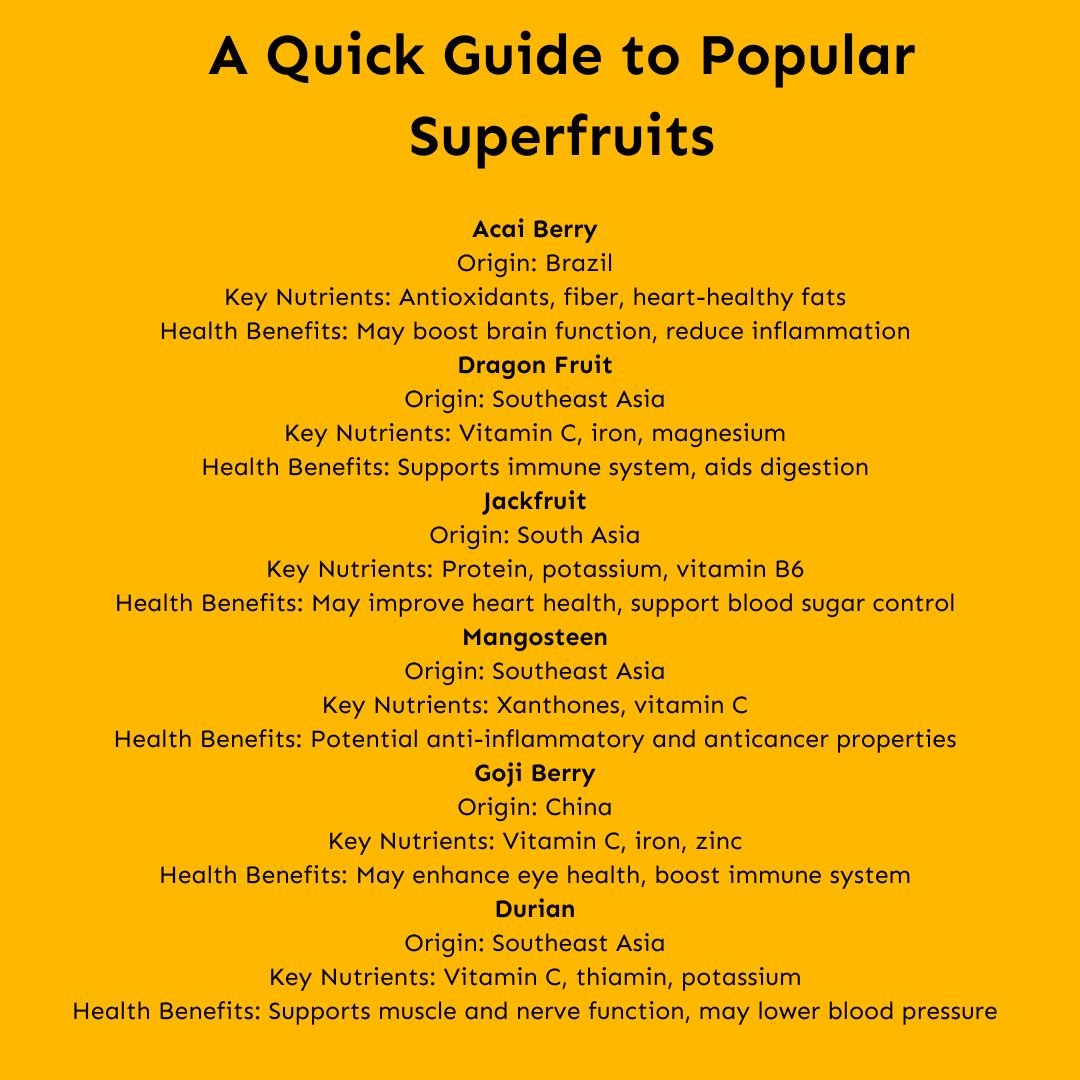Superfruits: Your Guide to Nutritional Powerhouses.
In recent years, the term "superfruit" has become increasingly popular in health and nutrition circles. But what exactly are superfruits, and why should they be a part of your diet? Let's explore the world of these exotic nutritional powerhouses and discover how they can enhance your health and culinary experiences.
What are Superfruits?
Superfruits are fruits that are exceptionally rich in nutrients, antioxidants, and other beneficial compounds. Often exotic and sourced from various parts of the world, these fruits are celebrated for their potential health benefits, which can range from boosting immune function to supporting heart health.
Here's a handy reference table of some well-known superfruits, their origins, and key benefits:
Now, let's dive deeper into each of these superfruits:
Acai Berry
Taste and Texture: Acai berries have a unique taste often described as a blend of blackberries and unsweetened chocolate. They have a creamy texture when pureed.
How to Incorporate: Acai bowls are a popular way to enjoy this superfruit. Blend frozen acai puree with other fruits and top with granola, nuts, and honey. You can also add acai powder to smoothies or sprinkle it over yogurt.
Dragon Fruit
Taste and Texture: Dragon fruit has a mildly sweet flavor, often compared to a cross between a kiwi and a pear. Its texture is similar to that of kiwifruit, with crunchy seeds embedded in soft flesh.
How to Incorporate: Enjoy dragon fruit fresh as a snack, add it to fruit salads, or use it as a colorful topping for smoothie bowls. It can also be blended into smoothies or used as a natural food coloring.
Jackfruit
Taste and Texture: Ripe jackfruit is sweet with a flavour reminiscent of pineapple, mango, and banana. It has a fibrous texture that becomes soft when ripe.
How to Incorporate: Ripe jackfruit can be eaten fresh or added to desserts. Unripe jackfruit is often used as a meat substitute in savory dishes due to its texture when cooked.
Mangosteen
Taste and Texture: Mangosteen has a delicate, sweet-tart flavor often described as a mix of lychee, peach, and strawberry. Its texture is similar to that of a ripe plum.
How to Incorporate: Mangosteen is best enjoyed fresh. Simply peel and eat the white segments inside. It can also be added to fruit salads or used to flavor beverages.
Goji Berry
Taste and Texture: Goji berries have a sweet and slightly tart flavor, similar to cranberries but less acidic. They have a chewy texture when dried.
How to Incorporate: Add dried goji berries to trail mix, oatmeal, or yogurt. They can also be rehydrated and added to teas or used in baking.
Durian
Taste and Texture: Durian has a complex flavor profile that some describe as a mix of savory, sweet, and creamy. Its texture is custard-like.
How to Incorporate: Durian can be eaten fresh, used in desserts like ice cream or cakes, or even incorporated into savory dishes in Southeast Asian cuisine.
While superfruits offer numerous health benefits, it's important to remember that they should be part of a balanced diet. These fruits are not miracle cures, and their effects can vary from person to person. Always consult with a healthcare professional before making significant changes to your diet, especially if you have existing health conditions or are taking medications.
By incorporating a variety of superfruits into your diet, you can enjoy their unique flavours while potentially boosting your overall health. Remember, moderation is key, and it's always best to consume a diverse range of fruits and vegetables for optimal nutrition.
From The Epicerie with love







